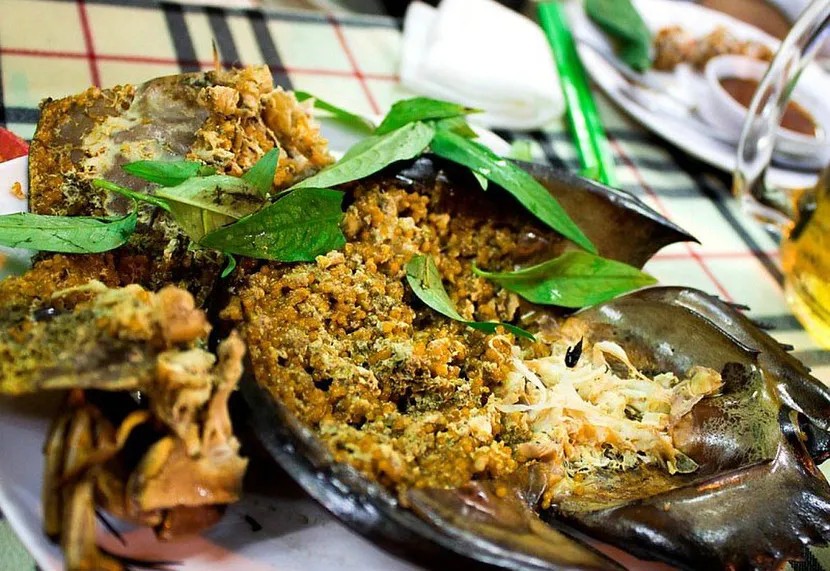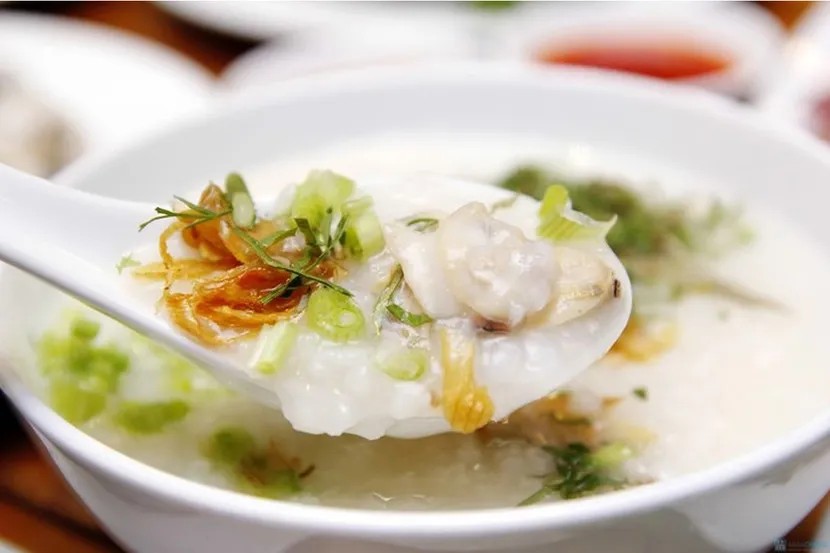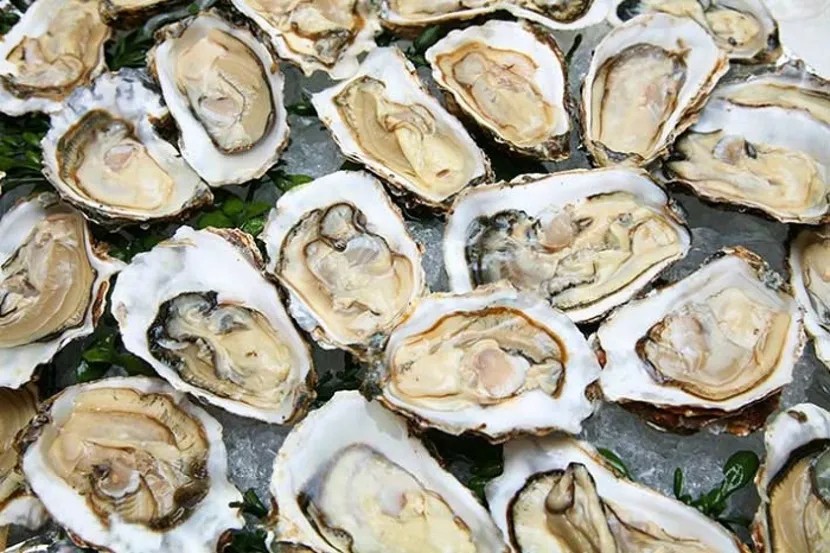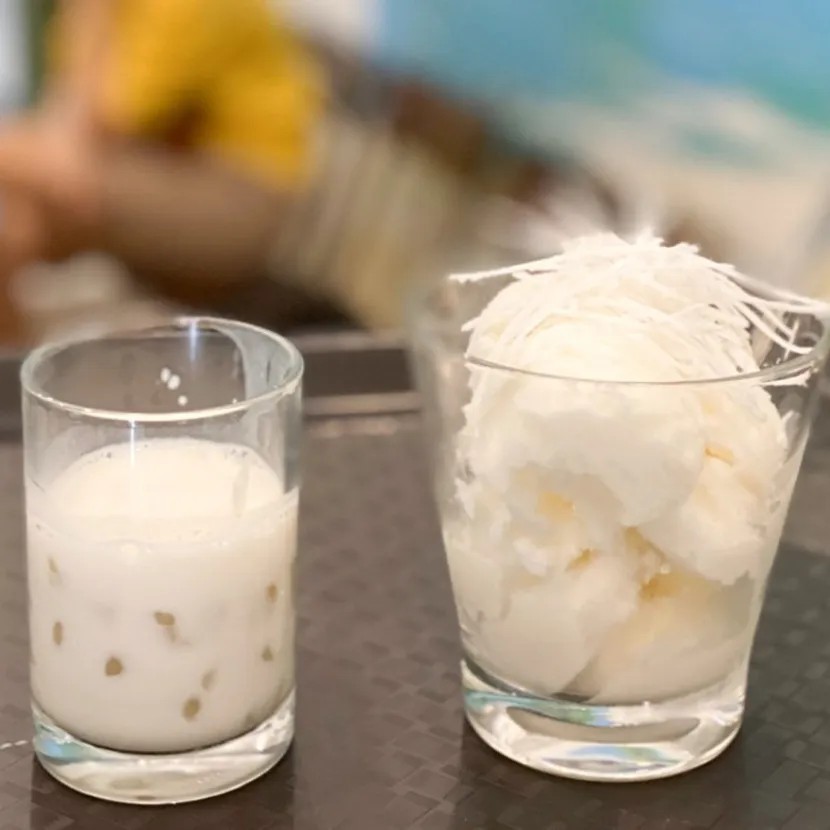Are you planning a trip to Halong Bay and eager to explore its unique cuisine? “Banh Gat Gu,” or Nodding Cake, is a must-try dish that embodies the flavors of Halong. Let SIXT.VN guide you through this culinary adventure and discover the best of Vietnamese cuisine, ensuring a seamless and unforgettable travel experience. With SIXT.VN, easily arrange airport transfers, book hotels, and explore exciting Halong Bay tours.
1. What Exactly is “Banh Gat Gu” (Nodding Cake)?
“Banh Gat Gu” (Nodding Cake) is a unique and delightful dish from Halong Bay, Vietnam, characterized by its soft, slightly bouncy texture and savory flavors. This dish is made from steamed rice flour and is often compared to Hanoi’s Pho due to its similar appearance but distinct taste and preparation. According to a culinary expert from the Vietnam National Administration of Tourism in 2022, Banh Gat Gu stands out because of its special sauce and the unique method of preparing the rice flour, giving it a signature texture.
The name “Nodding Cake” comes from two interesting theories: some say the cake nods when you pick it up, and others believe diners nod in approval due to its delicious taste. Regardless of the origin of its name, Banh Gat Gu has captured the hearts (and palates) of both locals and tourists.
1.1. What Makes Banh Gat Gu Unique?
Banh Gat Gu distinguishes itself through several factors:
- Unique Texture: The cake’s soft, spongy texture is achieved by a meticulous process of soaking rice overnight, crushing it in the morning, and adding cool rice during the process.
- Special Sauce: The dipping sauce is a crucial component, enhancing the overall flavor profile with a savory and slightly sweet taste.
- Savory Toppings: It is typically served with caramelized pork or minced pork with dry onions, adding a rich and flavorful element to the dish.
1.2. What Does Banh Gat Gu Taste Like?
Banh Gat Gu offers a delightful blend of flavors and textures:
- Soft and Chewy Cake: The rice flour cake is soft, slightly chewy, and has a mild, clean taste.
- Savory Pork: The caramelized or minced pork adds a savory and rich flavor that complements the cake.
- Flavorful Sauce: The dipping sauce is the star, providing a balance of sweet, savory, and slightly tangy notes.
1.3. Where Can You Find Authentic Banh Gat Gu in Halong?
To experience authentic Banh Gat Gu, consider visiting these locations in Halong:
- Halong Market: Known for its wide variety of local dishes, Halong Market offers some of the most authentic versions of Banh Gat Gu.
- Van Xuan Street, Bach Dang Ward: This area is renowned for its street food vendors, many of whom specialize in Banh Gat Gu.
- Local Eateries: Many small eateries throughout Halong Bay serve Banh Gat Gu, often prepared with family recipes passed down through generations.
2. The Fascinating History and Origin of Banh Gat Gu
The history of Banh Gat Gu is deeply rooted in the culinary traditions of Halong Bay, reflecting the region’s unique ingredients and cooking methods. According to historical records from the Quang Ninh Department of Culture, Sports and Tourism, the dish originated as a simple, affordable meal for local residents, utilizing locally sourced rice and pork.
2.1. How Did Banh Gat Gu Originate?
Banh Gat Gu was created out of necessity and resourcefulness. Local communities in Halong Bay sought to create a filling and tasty dish using the ingredients they had readily available. Rice flour was a staple, and pork was a common source of protein. The combination of these ingredients, along with a unique dipping sauce, led to the creation of Banh Gat Gu.
2.2. What is The Cultural Significance of Nodding Cake in Halong?
Banh Gat Gu holds significant cultural value in Halong Bay:
- Culinary Heritage: It represents the region’s culinary heritage, showcasing traditional cooking techniques and flavors.
- Local Identity: The dish is a symbol of local identity, often associated with family gatherings, festivals, and special occasions.
- Tourism Attraction: Banh Gat Gu has become a popular attraction for tourists, drawing visitors who want to experience authentic Halong cuisine.
2.3. How Has Banh Gat Gu Evolved Over Time?
Over the years, Banh Gat Gu has evolved while maintaining its core essence:
- Ingredient Variations: While the basic ingredients remain the same, some variations include different types of pork (caramelized vs. minced) and additions to the dipping sauce.
- Presentation: Modern presentations of Banh Gat Gu may include more elaborate garnishes and serving styles to appeal to tourists.
- Commercialization: With the rise of tourism, Banh Gat Gu has become more widely available in restaurants and eateries, catering to a broader audience.
3. How to Make Banh Gat Gu: A Step-by-Step Guide
Creating Banh Gat Gu at home can be a rewarding culinary experience, allowing you to recreate the flavors of Halong Bay in your own kitchen.
3.1. What are The Key Ingredients You’ll Need?
To make authentic Banh Gat Gu, gather the following ingredients:
| Ingredient | Quantity | Notes |
|---|---|---|
| Rice Flour | 200g | Use high-quality rice flour for the best texture. |
| Cooked Rice | 50g | Add to the rice flour mixture for a spongy texture. |
| Pork (Minced/Caramelized) | 150g | Choose your preferred style of pork. |
| Dry Onions | 1 tbsp | Finely chopped for the pork topping. |
| Fish Sauce | 2 tbsp | Essential for the dipping sauce. |
| Lime Juice | 1 tbsp | Adds tanginess to the dipping sauce. |
| Sugar | 1 tbsp | Balances the flavors in the dipping sauce. |
| Chili (Optional) | To taste | Adds a spicy kick to the dipping sauce. |
| Water | As needed | For mixing the rice flour. |
| Cooking Oil | For greasing pans | Prevents the cake from sticking. |
3.2. Step-by-Step Instructions for Preparing Banh Gat Gu
Follow these detailed steps to prepare Banh Gat Gu:
- Prepare the Rice Flour Mixture:
- In a bowl, mix the rice flour with enough water to form a smooth batter.
- Add the cooked rice to the batter and mix well. This step is crucial for achieving the signature spongy texture.
- Let the mixture sit for about 30 minutes.
- Steam the Rice Cake:
- Grease a flat pan or tray with cooking oil.
- Pour a thin layer of the rice flour mixture onto the pan.
- Steam for about 2-3 minutes, or until the cake is cooked and slightly translucent.
- Carefully remove the cake from the pan and let it cool slightly.
- Prepare the Pork Topping:
- If using minced pork, sauté it with finely chopped dry onions until cooked through. Season with a bit of fish sauce and pepper.
- If using caramelized pork, prepare it separately by simmering pork slices in a mixture of fish sauce, sugar, and water until caramelized and tender.
- Make the Dipping Sauce:
- In a small bowl, mix fish sauce, lime juice, sugar, and chili (if using). Adjust the quantities to your taste preference.
- Assemble and Serve:
- Cut the steamed rice cake into noodle-like strips.
- Arrange the strips on a plate.
- Top with the pork topping and drizzle generously with the dipping sauce.
- Serve immediately and enjoy!
3.3. Tips and Tricks for Perfect Banh Gat Gu
- Use Fresh Ingredients: Fresh, high-quality ingredients are essential for the best flavor and texture.
- Control the Steam: Ensure the steam is consistent to cook the rice cake evenly.
- Adjust the Sauce: Customize the dipping sauce to your preferred level of sweetness, sourness, and spiciness.
- Serve Immediately: Banh Gat Gu is best enjoyed fresh, while the cake is still soft and the flavors are vibrant.
4. Exploring Variations of Banh Gat Gu Across Halong Bay
While the basic recipe for Banh Gat Gu remains consistent, variations can be found throughout Halong Bay, reflecting local preferences and culinary creativity.
4.1. Regional Variations in Ingredients and Preparation
- Pork Variations: Some regions prefer using caramelized pork for a sweeter flavor, while others opt for minced pork with dry onions for a savory taste.
- Sauce Variations: Dipping sauces can vary in their balance of fish sauce, lime juice, sugar, and chili, with some regions preferring a sweeter sauce and others a spicier one.
- Rice Flour Blends: Some cooks may add other types of flour to the rice flour mixture to alter the texture of the cake.
4.2. Unique Twists on the Classic Banh Gat Gu Recipe
- Vegetarian Options: Some eateries offer vegetarian versions of Banh Gat Gu, using tofu or mushrooms as a substitute for pork.
- Seafood Additions: Given Halong Bay’s coastal location, some variations include seafood additions, such as shrimp or squid, to the topping.
- Herbal Infusions: Infusing the rice flour mixture with local herbs can add unique aromatic notes to the cake.
4.3. Where to Find These Variations in Halong Bay
To explore the diverse variations of Banh Gat Gu, visit these locations:
- Local Markets: Halong Market and other local markets are great places to find street food vendors offering unique twists on the classic recipe.
- Family-Owned Eateries: Small, family-owned eateries often have their own special recipes passed down through generations.
- Culinary Tours: Consider joining a culinary tour to sample a variety of Banh Gat Gu variations and learn about their origins and preparation.
5. Why “Banh Gat Gu” is a Must-Try Dish in Halong Bay
Banh Gat Gu is more than just a dish; it’s an experience that encapsulates the culinary essence of Halong Bay.
5.1. What Makes Banh Gat Gu a Culinary Highlight?
- Unique Flavor Profile: The combination of soft rice cake, savory pork, and flavorful dipping sauce creates a memorable taste experience.
- Cultural Significance: The dish reflects the region’s culinary heritage and local identity.
- Accessibility: Banh Gat Gu is widely available and affordable, making it accessible to all travelers.
5.2. How Does it Reflect Halong Bay’s Culinary Identity?
Banh Gat Gu embodies Halong Bay’s culinary identity through:
- Local Ingredients: The use of locally sourced rice and pork highlights the region’s agricultural resources.
- Traditional Techniques: The dish is prepared using traditional cooking methods passed down through generations.
- Community Connection: Banh Gat Gu is often enjoyed during family gatherings and local festivals, fostering a sense of community.
5.3. Tips for Enjoying Banh Gat Gu to The Fullest
- Eat it Fresh: Banh Gat Gu is best enjoyed immediately after it’s prepared, while the cake is still soft and the flavors are vibrant.
- Try Different Variations: Explore the different variations available throughout Halong Bay to discover your favorite.
- Pair it with Local Drinks: Enjoy Banh Gat Gu with local drinks such as Vietnamese iced coffee or herbal tea for a complete culinary experience.
6. Other Must-Try Halong Bay Dishes
While Banh Gat Gu is a highlight, Halong Bay offers a wealth of other culinary delights that are worth exploring.
6.1. Cha Muc (Squid Cake)
 Halong Bay Squid Cake
Halong Bay Squid Cake
Cha Muc (Squid Cake) is a quintessential Halong dish, made from pounded squid and seasoned with local spices. It is known for its chewy texture and savory flavor, often served with fish sauce and fresh herbs. According to the Quang Ninh Tourism Promotion Center, Cha Muc is one of the most popular souvenirs for tourists visiting Halong Bay.
Where to eat: Goc Bang Roll & Grilled Chopped Squid Restaurant, Bach Dang Ward, Ha Long City.
6.2. Sam (Horseshoe Crab)
Sam (Horseshoe Crab) is a unique seafood delicacy in Halong Bay, prepared in various ways such as grilling, frying, and making salads. Its distinctive flavor and texture, combined with aromatic spices, make it a memorable culinary experience. The horseshoe crab’s regenerative powers also make it a source for medicine and its shells can be crafted into souvenirs.
Where to eat: Sam Restaurant, Ha Long Market.
6.3. Ngan (Austriella Corrugata)
Ngan (Austriella Corrugata) is a clam-like sea creature that is a local specialty in Halong Bay. It can be grilled, steamed, or used in soups, offering a briny and slightly sweet flavor. Its fresh blood is also used to make wine, believed to have invigorating properties.
Where to eat: Thien Anh Seafood Restaurant, in Cai Dam Urban Area, Bai Chay.
6.4. Sa Sung (Peanut Worm or Sipunculus Nudus)
 Fried Peanut Worm
Fried Peanut Worm
Sa Sung (Peanut Worm) is a sea worm considered a delicacy in Halong Bay, often stir-fried with garlic or grilled. This worm is so nutritious that it’s even nicknamed “sea ginseng”. Historically, it was so special that people offered it to Kings and Mandarins. It is known for its unique texture and umami-rich flavor.
Where to eat: Huong Duyen Hon Gai Restaurant, 66 Tran Hung Dao Street, Ha Long City.
6.5. Chao Ha (Acorn Barnacle Porridge)
 Acorn Barnacle Porridge
Acorn Barnacle Porridge
Chao Ha (Acorn Barnacle Porridge) is a comforting and nutritious dish made with acorn barnacles, herbs, and spices. It is a popular choice for a warm and satisfying meal, especially on cooler days.
Where to eat: Co Hang Restaurant, 42 Tran Hung Dao Street, Ha Long City.
6.6. Bun Be Be (Noodles With Mantis Shrimp)
Bun Be Be (Noodles with Mantis Shrimp) is a flavorful noodle dish featuring mantis shrimp, fish, fried tofu, and fresh greens. The firm, sweet flesh of the mantis shrimp makes it a standout dish, perfect for breakfast or lunch.
Where to eat: Local markets or seafood markets.
6.7. Oysters
 Halong Bay Seafood
Halong Bay Seafood
Oysters are abundant in Halong Bay and are known for their fresh, briny taste. They can be enjoyed raw with lemon, grilled, baked with cheese, or steamed with herbs, offering a variety of flavors and textures. Halong’s oysters have a thin shell, soft body, and lots of minerals without a fishy smell.
Where to eat: Phuong Nam or Linh Dan restaurant.
6.8. Blood Pudding Stew with Mugwort
Blood pudding stew with mugwort is a traditional Vietnamese dish known for its medicinal properties. The slightly bitter taste of mugwort infuses the perfectly cubed blood, creating an unforgettable flavor. It’s high in protein, so moderation is key.
Where to eat: Ha Long Market, Van Xuan Street, Bach Dang Ward, Ha Long City.
6.9. Halong Tapioca Yogurt
 Halong Food Yogurt
Halong Food Yogurt
Halong Tapioca Yogurt is a delightful dessert featuring creamy yogurt paired with warm, homemade tapioca balls and coconut milk. It is a popular treat among locals and tourists alike. These bobas are immersed in sweet, homemade coconut milk, creating a delightful blend of flavors.
Where to eat: Lien Tuan or Co Nghi restaurants.
7. Planning Your Culinary Adventure in Halong Bay with SIXT.VN
To make the most of your culinary adventure in Halong Bay, consider using SIXT.VN for all your travel needs.
7.1. How SIXT.VN Can Enhance Your Travel Experience
SIXT.VN offers a range of services to ensure a seamless and enjoyable trip:
- Airport Transfers: Arrange for convenient and reliable airport transfers to and from Halong Bay.
- Hotel Booking: Choose from a wide selection of hotels to suit your budget and preferences.
- Tours and Activities: Book exciting tours and activities to explore Halong Bay’s natural beauty and cultural attractions.
- Car Rentals: Rent a car for greater flexibility and independence in exploring the region.
7.2. Booking Airport Transfers, Hotels, and Tours with SIXT.VN
Booking your travel arrangements with SIXT.VN is easy and convenient:
- Visit the SIXT.VN website.
- Select your desired services (airport transfers, hotels, tours).
- Enter your travel dates and preferences.
- Choose from a variety of options and book securely online.
- Receive instant confirmation and detailed travel information.
7.3. Why Choose SIXT.VN for Your Halong Bay Trip?
- Convenience: SIXT.VN provides a one-stop-shop for all your travel needs.
- Reliability: SIXT.VN partners with trusted service providers to ensure quality and reliability.
- Expert Support: SIXT.VN offers expert support to assist you with any questions or concerns.
- Competitive Pricing: SIXT.VN offers competitive pricing to help you save money on your trip.
8. Essential Travel Tips for Exploring Halong Bay
To ensure a smooth and enjoyable trip to Halong Bay, keep these essential travel tips in mind.
8.1. Best Time to Visit Halong Bay
- Spring (March to May): Pleasant temperatures and clear skies make this an ideal time to visit.
- Autumn (September to November): Similar to spring, autumn offers comfortable weather and beautiful scenery.
- Avoid Summer (June to August): This is the peak tourist season, with hot and humid weather and potential for storms.
- Consider Winter (December to February): While cooler, winter can still be a good time to visit if you don’t mind the lower temperatures and occasional fog.
8.2. What to Pack for Your Trip
- Light Clothing: Pack light, breathable clothing suitable for warm and humid weather.
- Swimsuit: Don’t forget your swimsuit for swimming and water activities.
- Sunscreen and Hat: Protect yourself from the sun with sunscreen and a hat.
- Comfortable Shoes: Wear comfortable shoes for walking and hiking.
- Rain Gear: Pack rain gear, especially if visiting during the rainy season.
8.3. Important Local Customs and Etiquette
- Respect Local Culture: Dress modestly when visiting temples and pagodas.
- Remove Shoes: Remove your shoes when entering someone’s home or certain religious sites.
- Bargaining: Bargaining is common in markets, but do so respectfully.
- Tipping: Tipping is not mandatory but is appreciated for good service.
9. Common Misconceptions About Vietnamese Cuisine
There are several common misconceptions about Vietnamese cuisine that are worth clarifying before your culinary adventure.
9.1. Myth: Vietnamese Food is Always Spicy
While some Vietnamese dishes can be spicy, many are mild and flavorful, with a focus on fresh herbs and balanced flavors. Chili is often served on the side, allowing you to adjust the spiciness to your preference.
9.2. Myth: All Vietnamese Food Contains Fish Sauce
Fish sauce is a staple ingredient in Vietnamese cuisine, but not all dishes contain it. Vegetarian and vegan options are available, using soy sauce or other plant-based seasonings.
9.3. Myth: Vietnamese Food is Unhygienic
Vietnamese cuisine is generally prepared with fresh ingredients and соблюдает basic hygiene standards. However, it’s always a good idea to choose reputable restaurants and street food vendors to ensure food safety.
10. Frequently Asked Questions (FAQ) About “Banh Gat Gu”
To further enhance your understanding of Banh Gat Gu, here are some frequently asked questions:
10.1. What Does “Gat Gu” Mean?
“Gat Gu” translates to “nodding” in Vietnamese, referring either to the way the cake nods when picked up or the diners nodding in approval.
10.2. Is Banh Gat Gu Gluten-Free?
No, Banh Gat Gu is not gluten-free as it is made from rice flour.
10.3. Can I Make Banh Gat Gu at Home?
Yes, you can make Banh Gat Gu at home by following the step-by-step guide provided earlier in this article.
10.4. What is The Best Way to Store Leftover Banh Gat Gu?
Store leftover Banh Gat Gu in the refrigerator and consume it within 1-2 days. Reheat before serving.
10.5. Are There Any Health Benefits to Eating Banh Gat Gu?
Banh Gat Gu is a good source of carbohydrates and provides some protein from the pork topping. However, it should be consumed in moderation as part of a balanced diet.
10.6. Where Can I Find The Best Banh Gat Gu in Halong Bay?
The best Banh Gat Gu can be found at local markets, family-owned eateries, and street food vendors throughout Halong Bay.
10.7. What is The Difference Between Banh Gat Gu and Pho?
While Banh Gat Gu and Pho both use rice noodles, they are distinct dishes with different ingredients, preparation methods, and flavors.
10.8. Can I Request a Vegetarian Version of Banh Gat Gu?
Yes, many eateries offer vegetarian versions of Banh Gat Gu with tofu or mushrooms as a substitute for pork.
10.9. What Other Dishes Should I Try in Halong Bay?
In addition to Banh Gat Gu, be sure to try Cha Muc (Squid Cake), Sam (Horseshoe Crab), and other local specialties.
10.10. How Can SIXT.VN Help Me Plan My Trip to Halong Bay?
SIXT.VN can assist with airport transfers, hotel bookings, tours, and other travel arrangements to ensure a seamless and enjoyable trip to Halong Bay.
Embark on your culinary journey to Halong Bay and savor the unique flavors of Banh Gat Gu and other local specialties. Let SIXT.VN be your trusted travel partner, ensuring a convenient, reliable, and unforgettable experience. Contact SIXT.VN today to book your airport transfers, hotels, and tours, and get ready to explore the wonders of Halong Bay. Address: 260 Cau Giay, Hanoi, Vietnam. Hotline/Whatsapp: +84 986 244 358. Website: SIXT.VN. Discover Halong Bay, indulge in authentic Vietnamese cuisine, and create memories that will last a lifetime!



